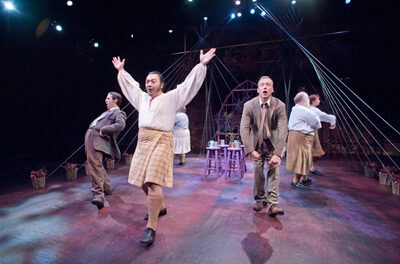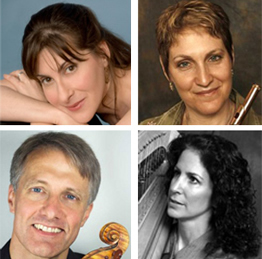The Raleigh Chamber Music Guild closed out its 2002-3 Masters series with a unique and exhilarating presentation. Either because of prohibitive costs for large groups or reticence to program beyond the usual configurations, most chamber music organizations tend to play it safe. This was certainly not the case on Sunday afternoon, April 27, as I Musici de Montreal presented a varied program at Meymandi Concert Hall. In existence since 1983, this group of fourteen string players and their cellist-conductor Yuli Turovsky have been the recipients of numerous awards and have 41 recordings on the Chandos label to their credit.
Both visually and aurally, it took some getting used to the relatively small forces assembled on the Meymandi stage. This hall was built and acoustically designed for a full symphony orchestra, and this was the first time that I had the opportunity to hear an ensemble other than that in it. I tried sitting in several different spots (only the downstairs seating was available for this concert), but the result was the same. The stage itself seemed to swallow up the sound, and there was not the projection and fullness that you get with a standard-size orchestra. However, that was a trifle compared to the extraordinary power and skill of this remarkable group.
Except for the two section cellists, all of the players performed standing in a semicircle throughout the entire concert. This is more visually appealing than the norm, and it seems to allow the players a greater sense of freedom and abandon. Viewing this arrangement with only fourteen players, one can’t help but be drawn into the old question of the necessity of a conductor. There are many groups this size and larger (the Orpheus Chamber Orchestra, for example) that do just fine sans stick-waver. Although there was certainly nothing to indicate that Turovsky, as a conductor, had a negative effect, it would be interesting to hear this group with him playing in the cello section, rather than on the podium.
The afternoon began with “Nocturne,” by Antonin Dvorák, in an arrangement that had a circuitous journey through severalrevisions of movements from two different string quartets. What especially struck me about this performance was the incredible pianissimo playing in the majority of the piece. At times it was barely audible, but there was still intensity and precision. Slow, quiet playing is deceptively hard to achieve, and within just a few moments you could tell you were in the presence of superb musicians.
Conductor/cello soloist Yuli Turovsky gave a not-so-brief introduction (he himself said he’d better stop so he didn’t end up talking longer than the piece!) to “The Nocturnal Dances of Don Juanquixote for Cello and Orchestra” by Finnish composer Aulis Sallinen. As is evidenced by its name, this work attempts to combine two of the greatest characters in Spanish folklore, Don Juan and Don Quixote. This work is a dizzying ride of brutally difficult cello technique, particularly the bowing. Turovsky handled his playing in a carefree and effortless manner that belied the immense challenges this work presents. If that wasn’t enough, he had double duties and continued to conduct the orchestra in what, at times, was an equally difficult accompaniment. He conceded before playing this work that it would probably take several hearings to acclimate to it (also as a plug to buy CDs in the lobby), but I found it to be a compelling work at first hearing.
Turovsky remained in his dual role as he next performed Carl Maria von Weber’s Adagio and Rondo for cello and orchestra. Here, he had a chance to also demonstrate his lovely slow, lyrical playing before erupting into the fireworks of the Rondo. This is a typical “showcase” piece, and Turovsky handled every virtuosic display with complete control and ease.
The second half was a very interesting mix of two works that ordinarily would not appear to have much in common aside from the fact that both have “night” in their titles. Some people might automatically cringe at the sight of “Schoenberg” on the program, but “Verklärte Nacht” (“Transfigured Night”) is probably his most accessible work. It began life as a string sextet and attempts to reconcile the Brahms/Wagner polarity that was a popular conflict in late Romantic music. The program included the 1896 poem by Richard Dehmel. This is a dense work that was convincingly played. Here is where I felt that the presence of a conductor did the most damage. It felt a bit like the musicians were giving up the quality of chamber music in looking to a “leader.”
Turning 180 degrees from a “scary” composer, the visitors played one of the most popular works in all of music. Mozart’s serenade “Eine kleine Nachtmusik” is probably at, or near, the top of every list of most favorite classical works. Jaded concertgoers and critics most likely groan at the thought of hearing this – yet again. However, this performance by I Musici de Montreal again proved that the problem is, often, boring, play-by-the-numbers musicians: any great work, no matter how often it is played, can and should reveal something new and fresh. The playing on this occasion was not only precise and wonderfully phrased but it had energy and life that drew in even those who were hearing it for the hundredth time. The ensemble took the final movement at a tempo that, at first, seemed impossible to sustain, but overall this was all a finely polished and beautiful example of the height of classical style.












